Subclass: Theria
Infraclass: Metatheria
Superorder: Ameridelphia

( Caluromys sp.)






Order: Didelphimorphia (common opossums)
Didelphimorphia is the order of common opossums of the Western Hemisphere. Opossums probably diverged from the basic South American marsupials in the late Cretaceous or early Paleocene. They are small to medium-sized marsupials, about the size of a large house cat, with a long snout and prehensile tail.
- Family: Didelphidae (American opossums)
- Subfamily: Caluromyinae
- Genus: Caluromys
- Brown-eared woolly opossum, C. lanatus LC
- Genus: Caluromys
- Subfamily: Didelphinae
- Genus: Chacodelphys
- Chacoan pygmy opossum, Chacodelphys formosaNT
- Genus: Chironectes
- Water opossum, Chironectes minimus LC
- Genus: Cryptonanus
- Chacoan gracile opossum, Cryptonanus chacoensis LC
- Red-bellied gracile opossum, Cryptonanus ignitusEX
- Genus: Didelphis
- White-eared opossum, Didelphis albiventris LC
- Big-eared opossum, Didelphis aurita LC
- Genus: Gracilinanus
- Agile gracile opossum, Gracilinanus agilis LC
- Brazilian gracile opossum, Gracilinanus microtarsus LC
- Genus: Lestodelphys
- Patagonian opossum, Lestodelphys halli LC
- Genus: Lutreolina
- Big lutrine opossum, Lutreolina crassicaudata LC
- Massoia's lutrine opossum, Lutreolina massoia LC
- Genus: Marmosa
- Subgenus: Micoureus
- White-bellied woolly mouse opossum, Marmosa constantiae LC
- Tate's woolly mouse opossum, Marmosa paraguayana LC
- Subgenus: Micoureus
- Genus: Metachirus
- Brown four-eyed opossum, Metachirus nudicaudatus LC
- Genus: Monodelphis
- Yellow-sided opossum, Monodelphis dimidiata LC
- Gray short-tailed opossum, Monodelphis domestica LC
- Pygmy short-tailed opossum, Monodelphis kunsi LC
- Long-nosed short-tailed opossum, Monodelphis scalops LC
- Southern red-sided opossum, Monodelphis sorex LC
- One-striped opossum, Monodelphis unistriataCR
- Genus: Philander
- Southeastern four-eyed opossum, Philander frenata LC
- Genus: Thylamys
- Cinderella fat-tailed mouse opossum, Thylamys cinderella LC
- Elegant fat-tailed mouse opossum, Thylamys elegans LC
- White-bellied fat-tailed mouse opossum, Thylamys pallidior LC
- Common fat-tailed mouse opossum, Thylamys pusillus LC
- Argentine fat-tailed mouse opossum, Thylamys sponsorius LC
- Buff-bellied fat-tailed mouse opossum, Thylamys venustusDD
- Genus: Chacodelphys
- Subfamily: Caluromyinae
Order: Paucituberculata (shrew opossums)
There are six extant species of shrew opossum. They are small shrew-like marsupials confined to the Andes.
- Family: Caenolestidae
- Genus: Rhyncholestes
- Long-nosed caenolestid, Rhyncholestes raphanurusNT
- Genus: Rhyncholestes
Superorder: Australidelphia

Order: Microbiotheria (monito del monte)
The monito del monte is the only extant member of its family and the only surviving member of an ancient order, Microbiotheria. It appears to be more closely related to Australian marsupials than to other Neotropic marsupials; this is a reflection of the South American origin of all Australasian marsupials. [1]
- Family: Microbiotheriidae
- Genus: Dromiciops
- Monito del monte, D. gliroidesNT
- Genus: Dromiciops
Infraclass: Eutheria
Superorder: Xenarthra

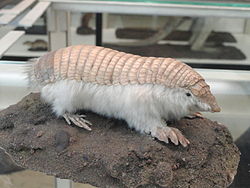



Order: Cingulata (armadillos)
Armadillos are small mammals with a bony armored shell. There are 21 extant species in the Americas, 19 of which are only found in South America, where they originated. Their much larger relatives, the pampatheres and glyptodonts, once lived in North and South America but became extinct following the appearance of humans.
- Family: Dasypodidae (long-nosed armadillos)
- Subfamily: Dasypodinae
- Genus: Dasypus
- Southern long-nosed armadillo, Dasypus hybridusNT
- Nine-banded armadillo, Dasypus novemcinctus LC
- Seven-banded armadillo, Dasypus septemcinctus LC
- Yepes's mulita, Dasypus yepesiDD
- Genus: Dasypus
- Subfamily: Dasypodinae
- Family: Chlamyphoridae (armadillos)
- Subfamily Chlamyphorinae
- Genus: Calyptophractus
- Greater fairy armadillo, Calyptophractus retususDD
- Genus: Chlamyphorus
- Pink fairy armadillo, Chlamyphorus truncatusDD
- Genus: Calyptophractus
- Subfamily: Euphractinae
- Genus: Chaetophractus
- Andean hairy armadillo, Chaetophractus nationiNE
- Screaming hairy armadillo, Chaetophractus vellerosus LC
- Big hairy armadillo, Chaetophractus villosus LC
- Genus: Euphractus
- Six-banded armadillo, Euphractus sexcinctus LC
- Genus: Zaedyus
- Pichi, Zaedyus pichiyNT
- Genus: Chaetophractus
- Subfamily: Tolypeutinae
- Genus: Cabassous
- Chacoan naked-tailed armadillo, Cabassous chacoensisNT
- Greater naked-tailed armadillo, Cabassous tatouay LC
- Genus: Priodontes
- Giant armadillo, Priodontes maximusVU
- Genus: Tolypeutes
- Southern three-banded armadillo, Tolypeutes matacusNT
- Genus: Cabassous
- Subfamily Chlamyphorinae
Order: Pilosa (anteaters, sloths and tamanduas)



The order Pilosa is extant only in the Americas and includes the anteaters, sloths, and tamanduas. Their ancestral home is South America. Numerous ground sloths, some of which reached the size of elephants, were once present in both North and South America, as well as on the Antilles, but all went extinct following the arrival of humans.
- Suborder: Folivora
- Family: Bradypodidae (three-toed sloths)
- Genus: Bradypus
- Brown-throated sloth, Bradypus variegatus LC possibly extirpated
- Genus: Bradypus
- Family: Bradypodidae (three-toed sloths)
- Suborder: Vermilingua
- Family: Myrmecophagidae (American anteaters)
- Genus: Myrmecophaga
- Giant anteater, Myrmecophaga tridactylaVU
- Genus: Tamandua
- Southern tamandua, Tamandua tetradactyla LC
- Genus: Myrmecophaga
- Family: Myrmecophagidae (American anteaters)
Superorder: Euarchontoglires
Order: Primates



The order Primates contains humans and their closest relatives: lemurs, lorisoids, tarsiers, monkeys, and apes.
- Suborder: Haplorhini
- Infraorder: Simiiformes
- Parvorder: Platyrrhini
- Family: Cebidae
- Subfamily: Cebinae
- Genus: Sapajus
- Black-striped capuchin, Sapajus libidinosusNT
- Black capuchin, Sapajus nigritusNT
- Genus: Sapajus
- Subfamily: Cebinae
- Family: Aotidae
- Genus: Aotus
- Azara's night monkey, Aotus azarae LC
- Genus: Aotus
- Family: Atelidae
- Subfamily: Alouattinae
- Genus: Alouatta
- Black howler, Alouatta caraya LC
- Brown howler, Alouatta guariba LC
- Genus: Alouatta
- Subfamily: Alouattinae
- Family: Cebidae
- Parvorder: Platyrrhini
- Infraorder: Simiiformes
Order: Rodentia (rodents)
















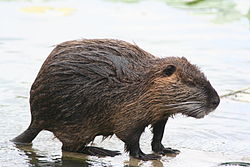
Rodents make up the largest order of mammals, with over 40 percent of mammalian species. They have two incisors in the upper and lower jaw which grow continually and must be kept short by gnawing. Most rodents are small though the capybara can weigh up to 45 kg (100 lb).
- Suborder: Hystricomorpha
- Family: Erethizontidae (New World porcupines)
- Subfamily: Erethizontinae
- Genus: Coendou
- Bicolored-spined porcupine, Coendou bicolor LC
- Brazilian porcupine, Coendou prehensilis LC
- Paraguaian hairy dwarf porcupine, Coendou spinosus LC
- Genus: Coendou
- Subfamily: Erethizontinae
- Family: Chinchillidae (viscachas and chinchillas)
- Genus: Chinchilla
- Short-tailed chinchilla, Chinchilla chinchillaEN
- Genus: Lagidium
- Southern viscacha, Lagidium viscacia LC
- Wolffsohn's viscacha, Lagidium wolffsohniDD
- Genus: Lagostomus
- Plains viscacha, Lagostomus maximus LC
- Genus: Chinchilla
- Family: Caviidae (guinea pigs)
- Subfamily: Caviinae
- Genus: Cavia
- Brazilian guinea pig, Cavia aperea LC
- Montane guinea pig, Cavia tschudii LC
- Genus: Galea
- Common yellow-toothed cavy, Galea musteloides LC
- Genus: Microcavia
- Southern mountain cavy, Microcavia australis LC
- Shipton's mountain cavy, Microcavia shiptoniNT
- Genus: Cavia
- Subfamily: Dolichotinae
- Genus: Dolichotis
- Patagonian mara, Dolichotis patagonumNT
- Chacoan mara, Dolichotis salinicola LC
- Genus: Dolichotis
- Subfamily: Hydrochoerinae (capybaras and rock cavies)
- Genus: Hydrochoerus
- Capybara, Hydrochoerus hydrochaeris LC
- Genus: Hydrochoerus
- Subfamily: Caviinae
- Family: Dasyproctidae (agoutis and pacas)
- Genus: Dasyprocta
- Azara's agouti, Dasyprocta azaraeDD
- Central American agouti, Dasyprocta punctata LC
- Genus: Dasyprocta
- Family: Cuniculidae
- Genus: Cuniculus
- Lowland paca, Cuniculus paca LC
- Genus: Cuniculus
- Family: Ctenomyidae
- Genus: Ctenomys
- Argentine tuco-tuco, Ctenomys argentinusNT
- Southern tuco-tuco, Ctenomys australisEN
- Azara's tuco-tuco, Ctenomys azaraeEN
- Berg's tuco-tuco, Ctenomys bergiEN
- Bolivian tuco-tuco, Ctenomys boliviensis LC
- Bonetto's tuco-tuco, Ctenomys bonettoiEN
- Budin's tuco-tuco, Ctenomys budiniNE
- Colburn's tuco-tuco, Ctenomys colburniDD
- Puntilla tuco-tuco, Ctenomys coludoDD
- Conover's tuco-tuco, Ctenomys conoveri LC
- D'Orbigny's tuco-tuco, Ctenomys dorbignyiNT
- Emily's tuco-tuco, Ctenomys emilianus LC
- Famatina tuco-tuco, Ctenomys famosusDD
- Foch's tuco-tuco, Ctenomys fochiDD
- Lago Blanco tuco-tuco, Ctenomys fodaxDD
- Reddish tuco-tuco, Ctenomys frater LC
- Tawny tuco-tuco, Ctenomys fulvusDD
- Haig's tuco-tuco, Ctenomys haigi LC
- San Juan tuco-tuco, Ctenomys johannisDD
- Jujuy tuco-tuco, Ctenomys jurisDD
- Catamarca tuco-tuco, Ctenomys knightiDD
- Mottled tuco-tuco, Ctenomys latroEN
- Magellanic tuco-tuco, Ctenomys magellanicus LC
- Maule tuco-tuco, Ctenomys maulinus LC
- Mendoza tuco-tuco, Ctenomys mendocinus LC
- Tiny tuco-tuco, Ctenomys minutusDD
- Furtive tuco-tuco, Ctenomys occultusEN
- Highland tuco-tuco, Ctenomys opimus LC
- Reig's tuco-tuco, Ctenomys osvaldoreigiCR
- Goya tuco-tuco, Ctenomys perrensis LC
- San Luis tuco-tuco, Ctenomys pontifexDD
- Porteous's tuco-tuco, Ctenomys porteousiNT
- Pundt's tuco-tuco, Ctenomys pundtiEN
- Rio Negro tuco-tuco, Ctenomys rionegrensisEN
- Roig's tuco-tuco, Ctenomys roigiCR
- Salta tuco-tuco, Ctenomys saltariusDD
- Scaglia's tuco-tuco, Ctenomys scagliaiDD
- Silky tuco-tuco, Ctenomys sericeusDD
- Social tuco-tuco, Ctenomys sociabilisCR
- Forest tuco-tuco, Ctenomys sylvanusDD
- Talas tuco-tuco, Ctenomys talarum LC
- Collared tuco-tuco, Ctenomys torquatus LC
- Robust tuco-tuco, Ctenomys tuconaxDD
- Tucuman tuco-tuco, Ctenomys tucumanusDD
- Sierra Tontal tuco-tuco, Ctenomys tulducoDD
- Strong tuco-tuco, Ctenomys validusDD
- Vipos tuco-tuco, Ctenomys viperinusDD
- Yolanda's tuco-tuco, Ctenomys yolandaeDD
- Genus: Ctenomys
- Family: Octodontidae
- Genus: Aconaemys
- Chilean rock rat, Aconaemys fuscus LC
- Sage's rock rat, Aconaemys sageiDD
- Genus: Octodon
- Bridges's degu, Octodon bridgesiVU
- Genus: Octodontomys
- Mountain degu, Octodontomys gliroides LC
- Genus: Octomys
- Mountain viscacha rat, Octomys mimax LC
- Genus: Pipanacoctomys
- Golden viscacha rat, Pipanacoctomys aureusCR
- Genus: Tympanoctomys
- Plains viscacha rat, Tympanoctomys barreraeNT
- Kirchner's viscacha rat, Tympanoctomys kirchnerorumDD
- Chalchalero viscacha rat, Tympanoctomys loschalchalerosorumCR
- Genus: Aconaemys
- Family: Abrocomidae
- Genus: Abrocoma
- Budin's chinchilla rat, Abrocoma budiniDD
- Ashy chinchilla rat, Abrocoma cinerea LC
- Famatina chinchilla rat, Abrocoma famatinaDD
- Sierra del Tontal chinchilla rat, Abrocoma shistacea LC
- Uspallata chinchilla rat, Abrocoma uspallataDD
- Punta de Vacas chinchilla rat, Abrocoma vaccarumDD
- Genus: Abrocoma
- Family: Echimyidae
- Subfamily: Dactylomyinae
- Genus: Kannabateomys
- Atlantic bamboo rat, Kannabateomys amblyonyx LC
- Genus: Kannabateomys
- Subfamily: Eumysopinae
- Genus: Euryzygomatomys
- Fischer's guiara, Euryzygomatomys spinosus LC
- Genus: Euryzygomatomys
- Subfamily: Dactylomyinae
- Family: Myocastoridae (coypus)
- Family: Erethizontidae (New World porcupines)


- Suborder: Sciurognathi
- Family: Castoridae (beavers)
- Genus: Castor
- American beaver, C. canadensisLC introduced
- Genus: Castor
- Family: Sciuridae (squirrels)
- Subfamily: Sciurinae
- Tribe: Sciurini
- Genus: Sciurus
- Brazilian squirrel, Sciurus aestuans LC
- Bolivian squirrel, Sciurus ignitus LC
- Genus: Sciurus
- Tribe: Sciurini
- Subfamily: Sciurinae
- Family: Castoridae (beavers)
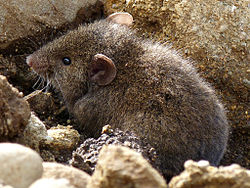



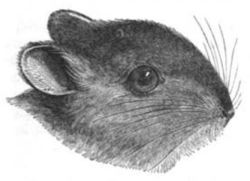
- Family: Cricetidae
- Subfamily: Sigmodontinae
- Genus: Abrawayaomys
- Abrawayaomys chebezi DD
- Ruschi's rat, Abrawayaomys ruschii LC
- Genus: Abrothrix
- Andean Altiplano mouse, Abrothrix andinus LC
- Gray grass mouse, Abrothrix illuteus LC
- Jelski's Altiplano mouse, Abrothrix jelskii LC
- Woolly grass mouse, Abrothrix lanosus LC
- Long-haired grass mouse, Abrothrix longipilis LC
- Olive grass mouse, Abrothrix olivaceus LC
- Sanborn's grass mouse, Abrothrix sanborniNT
- Genus: Akodon
- White-bellied grass mouse, Akodon albiventer LC
- Azara's grass mouse, Akodon azarae LC
- Bolivian grass mouse, Akodon boliviensis LC
- Budin's grass mouse, Akodon budini LC
- Akodon caenosus DD
- Cursor grass mouse, Akodon cursor LC
- Dolorous grass mouse, Akodon dolores LC
- Smoky grass mouse, Akodon fumeus LC
- Akodon glaucinus
- Intelligent grass mouse, Akodon iniscatus LC
- Altiplano grass mouse, Akodon lutescens LC
- Montane grass mouse, Akodon montensis LC
- Neuquén grass mouse, Akodon neocenusNE
- Paraná grass mouse, Akodon paranaensis LC
- Philip Myers's akodont, Akodon philipmyersiDD
- Akodon polopi LC
- White-throated grass mouse, Akodon simulator LC
- Spegazzini's grass mouse, Akodon spegazzinii LC
- Forest grass mouse, Akodon sylvanus LC
- Akodon tartareus
- Chaco grass mouse, Akodon toba LC
- Genus: Andalgalomys
- Olrog's chaco mouse, Andalgalomys olrogi LC
- Genus: Andinomys
- Andean mouse, Andinomys edax LC
- Genus: Auliscomys
- Andean big-eared mouse, Auliscomys sublimis LC
- Genus: Bibimys
- Chaco crimson-nosed rat, Bibimys chacoensis LC
- Large-lipped crimson-nosed rat, Bibimys labiosus LC
- Torres' crimson-nosed rat, Bibimys torresiVU
- Genus: Blarinomys
- Brazilian shrew-mouse, Blarinomys breviceps LC
- Genus: Brucepattersonius
- Guaraní brucie, Brucepattersonius guaraniDD
- Ihering's hocicudo, Brucepattersonius iheringi LC
- Misiones brucie, Brucepattersonius misionensisDD
- Arroyo of Paradise brucie, Brucepattersonius paradisusDD
- Genus: Calomys
- Bolivian vesper mouse, Calomys boliviae LC
- Crafty vesper mouse, Calomys callidus LC
- Large vesper mouse, Calomys callosus LC
- Small vesper mouse, Calomys laucha LC
- Andean vesper mouse, Calomys lepidus LC
- Drylands vesper mouse, Calomys musculinus LC
- Delicate vesper mouse, Calomys tener LC
- Córdoba vesper mouse, Calomys venustus LC
- Genus: Chelemys
- Andean long-clawed mouse, Chelemys macronyx LC
- Genus: Chinchillula
- Altiplano chinchilla mouse, Chinchillula sahamae LC
- Genus: Delomys
- Striped Atlantic Forest rat, Delomys dorsalis LC
- Genus: Deltamys
- Kemp's grass mouse, Deltamys kempi LC
- Genus: Eligmodontia
- Monte gerbil mouse, Eligmodontia moreni LC
- Morgan's gerbil mouse, Eligmodontia morgani LC
- Andean gerbil mouse, Eligmodontia puerulus LC
- Highland gerbil mouse, eastern Patagonian gerbil mouse, Eligmodontia typus LC
- Genus: Euneomys
- Patagonian chinchilla mouse, Euneomys chinchilloidesDD
- Burrowing chinchilla mouse, Euneomys fossor DD
- Biting chinchilla mouse, Euneomys mordax LC
- Peterson's chinchilla mouse, Euneomys petersoni LC
- Genus: Euryoryzomys
- Tarija rice rat, Euryoryzomys legatus LC
- Russet rice rat, Euryoryzomys russatus LC
- Genus: Geoxus
- Long-clawed mole mouse, Geoxus valdivianus LC
- Genus: Graomys
- Graomys chacoensis (contains the former Graomys centralis ) DD
- Pale leaf-eared mouse, Graomys domorum LC
- Edith's leaf-eared mouse, Graomys edithaeDD
- Gray leaf-eared mouse, Graomys griseoflavus LC
- Genus: Holochilus
- Web-footed marsh rat, Holochilus brasiliensis LC
- Chaco marsh rat, Holochilus chacarius LC
- Genus: Irenomys
- Chilean climbing mouse, Irenomys tarsalis LC
- Genus: Juliomys
- Lesser Wilfred's mouse, Juliomys pictipes LC
- Genus: Gyldenstolpia
- Fossorial giant rat, Gyldenstolpia frontoCR
- Genus: Loxodontomys
- Southern big-eared mouse, Loxodontomys micropus LC
- Genus: Necromys
- Argentine bolo mouse, Necromys benefactus LC
- Rufous-bellied bolo mouse, Necromys lactens LC
- Hairy-tailed bolo mouse, Necromys lasiurus LC
- Paraguayan bolo mouse, Necromys lenguarum LC
- Dark bolo mouse, Necromys obscurus LC
- Temchuk's bolo mouse, Necromys temchuki LC
- Genus: Nectomys
- Scaly-footed water rat, Nectomys squamipes LC
- Genus: Neotomys
- Andean swamp rat, Neotomys ebriosus LC
- Genus: Notiomys
- Edward's long-clawed mouse, Notiomys edwardsii LC
- Genus: Oligoryzomys
- Brenda's colilargo, Oligoryzomys brendaeDD
- Chacoan pygmy rice rat, Oligoryzomys chacoensis LC
- Destructive pygmy rice rat, Oligoryzomys destructor LC
- Yellow pygmy rice rat, Oligoryzomys flavescens LC
- Fornes' colilargo, Oligoryzomys fornesi LC
- Long-tailed pygmy rice rat, Oligoryzomys longicaudatus LC
- Magellanic pygmy rice rat, Oligoryzomys magellanicus LC
- Black-footed pygmy rice rat, Oligoryzomys nigripes LC
- Genus: Oxymycterus
- Argentine hocicudo, Oxymycterus akodontiusNE
- Hispid hocicudo, Oxymycterus hispidus LC
- Paramo hocicudo, Oxymycterus paramensis LC
- Quaestor hocicudo, Oxymycterus quaestor LC
- Red hocicudo, Oxymycterus rufus LC
- Genus: Phyllotis
- Los Alisos leaf-eared mouse, Phyllotis alisosiensis DD
- Anita's leaf-eared mouse, Phyllotis anitaeDD
- Buenos Aires leaf-eared mouse, Phyllotis bonariensisNT
- Capricorn leaf-eared mouse, Phyllotis caprinus LC
- Bunchgrass leaf-eared mouse, Phyllotis osilae LC
- Yellow-rumped leaf-eared mouse, Phyllotis xanthopygus LC
- Genus: Pseudoryzomys
- Brazilian false rice rat, Pseudoryzomys simplex LC
- Genus: Reithrodon
- Bunny rat, Reithrodon auritus LC
- Naked-soled conyrat, Reithrodon typicus LC
- Genus: Rhipidomys
- Southern climbing mouse, Rhipidomys austrinus LC
- Genus: Salinomys
- Delicate salt flat mouse, Salinomys delicatusDD
- Genus: Scapteromys
- Argentine swamp rat, Scapteromys aquaticus LC
- Waterhouse's swamp rat, Scapteromys tumidus LC
- Genus: Sooretamys
- Paraguayan rice rat, Sooretamys angouya LC
- Genus: Tapecomys
- Primordial tapecua, Tapecomys primus LC
- Genus: Thaptomys
- Blackish grass mouse, Thaptomys nigrita LC
- Genus: Abrawayaomys
- Subfamily: Sigmodontinae
- Family: Cricetidae
Order: Lagomorpha (lagomorphs)

The lagomorphs comprise two families, Leporidae (hares and rabbits), and Ochotonidae (pikas). Though they can resemble rodents, and were classified as a superfamily in that order until the early 20th century, they have since been considered a separate order. They differ from rodents in a number of physical characteristics, such as having four incisors in the upper jaw rather than two.
- Family: Leporidae (rabbits, hares)
- Genus: Sylvilagus
- Common tapetí, Sylvilagus brasiliensis EN
- Genus: Sylvilagus
Superorder: Laurasiatheria
Order: Chiroptera (bats)










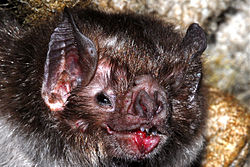
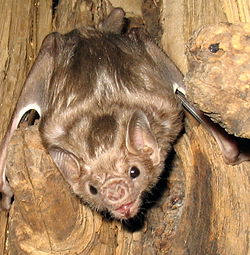
The bats' most distinguishing feature is that their forelimbs are developed as wings, making them the only mammals capable of flight. Bat species account for about 20% of all mammals.
- Family: Noctilionidae
- Genus: Noctilio
- Lesser bulldog bat, N. albiventris LC
- Greater bulldog bat, N. leporinus LC
- Genus: Noctilio
- Family: Vespertilionidae
- Subfamily: Myotinae
- Genus: Myotis
- Southern myotis, Myotis aelleniDD
- Silver-tipped myotis, Myotis albescens LC
- Chilean myotis, Myotis chiloensis LC
- Myotis dinellii LC
- Hairy-legged myotis, Myotis keaysi LC
- Yellowish myotis, Myotis levis LC
- Black myotis, Myotis nigricans LC
- Riparian myotis, Myotis riparius LC
- Red myotis, Myotis ruberNT
- Velvety myotis, Myotis simusDD
- Genus: Myotis
- Subfamily: Vespertilioninae
- Genus: Eptesicus
- Brazilian brown bat, Eptesicus brasiliensis LC
- Diminutive serotine, Eptesicus diminutus LC
- Argentine brown bat, Eptesicus furinalis LC
- Genus: Histiotus
- Thomas's big-eared brown bat, Histiotus laephotis LC
- Big-eared brown bat, Histiotus macrotus LC
- Southern big-eared brown bat, Histiotus magellanicus LC
- Small big-eared brown bat, Histiotus montanus LC
- Tropical big-eared brown bat, Histiotus velatusDD
- Genus: Lasiurus
- Desert red bat, Lasiurus blossevillii LC
- Hoary bat, Lasiurus cinereus LC
- Southern yellow bat, Lasiurus ega LC
- Cinnamon red bat, Lasiurus varius LC
- Genus: Eptesicus
- Subfamily: Myotinae
- Family: Molossidae
- Genus: Cynomops
- Cinnamon dog-faced bat, Cynomops abrasusDD
- Para dog-faced bat, Cynomops paranusDD
- Southern dog-faced bat, Cynomops planirostris LC
- Genus: Eumops
- Black bonneted bat, Eumops auripendulus LC
- Dwarf bonneted bat, Eumops bonariensis LC
- Big bonneted bat, Eumops dabbenei LC
- Wagner's bonneted bat, Eumops glaucinus LC
- Patagonian bonneted bat, Eumops patagonicus LC
- Western mastiff bat, Eumops perotis LC
- Genus: Molossops
- Rufous dog-faced bat, Molossops neglectusDD
- Dwarf dog-faced bat, Molossops temminckii LC
- Genus: Molossus
- Bonda mastiff bat, Molossus currentium LC
- Velvety free-tailed bat, Molossus molossus LC
- Black mastiff bat, Molossus rufus LC
- Genus: Nyctinomops
- Broad-eared bat, Nyctinomops laticaudatus LC
- Big free-tailed bat, Nyctinomops macrotis LC
- Genus: Promops
- Big crested mastiff bat, Promops centralis LC
- Brown mastiff bat, Promops nasutus LC
- Genus: Tadarida
- Mexican free-tailed bat, Tadarida brasiliensis LC
- Genus: Cynomops
- Family: Phyllostomidae
- Subfamily: Phyllostominae
- Genus: Chrotopterus
- Big-eared woolly bat, Chrotopterus auritus LC
- Genus: Macrophyllum
- Long-legged bat, Macrophyllum macrophyllum LC
- Genus: Phyllostomus
- Pale spear-nosed bat, Phyllostomus discolor LC
- Genus: Tonatia
- Greater round-eared bat, Tonatia bidensDD
- Genus: Chrotopterus
- Subfamily: Glossophaginae
- Genus: Anoura
- Tailed tailless bat, Anoura caudifer LC
- Genus: Glossophaga
- Pallas's long-tongued bat, Glossophaga soricina LC
- Genus: Anoura
- Subfamily: Carolliinae
- Genus: Carollia
- Seba's short-tailed bat, Carollia perspicillata LC
- Genus: Carollia
- Subfamily: Stenodermatinae
- Genus: Artibeus
- Fringed fruit-eating bat, Artibeus fimbriatus LC
- Great fruit-eating bat, Artibeus lituratus LC
- Flat-faced fruit-eating bat, Artibeus planirostris LC
- Genus: Platyrrhinus
- White-lined broad-nosed bat, Platyrrhinus lineatus LC
- Genus: Pygoderma
- Ipanema bat, Pygoderma bilabiatum LC
- Genus: Sturnira
- Hairy yellow-shouldered bat, Sturnira erythromos LC
- Little yellow-shouldered bat, Sturnira lilium LC
- Tschudi's yellow-shouldered bat, Sturnira oporaphilum LC
- Genus: Vampyressa
- Southern little yellow-eared bat, Vampyressa pusillaDD
- Genus: Artibeus
- Subfamily: Desmodontinae
- Genus: Desmodus
- Common vampire bat, Desmodus rotundus LC
- Genus: Diaemus
- White-winged vampire bat, Diaemus youngi LC
- Genus: Desmodus
- Subfamily: Phyllostominae
Order: Carnivora (carnivorans)
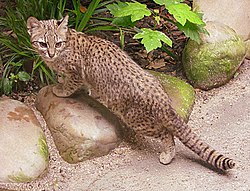
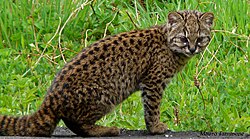
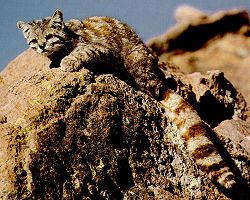
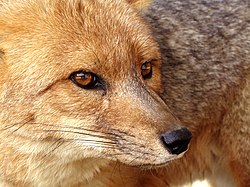





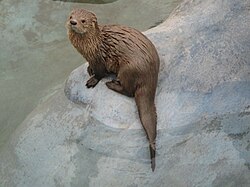

There are over 260 species of carnivorans, the majority of which feed primarily on meat. They have a characteristic skull shape and dentition.
- Suborder: Feliformia
- Family: Felidae (cats)
- Subfamily: Felinae
- Genus: Herpailurus
- Jaguarundi, H. yagouaroundiLC [2]
- Genus: Leopardus
- Pampas cat L. colocolaNT [3]
- Geoffroy's cat L. geoffroyiLC [4]
- Kodkod, L. guignaVU [5]
- Southern tigrina L. guttulusVU [6]
- Andean mountain cat L. jacobitusEN [7]
- Ocelot L. pardalisLC [8]
- Oncilla L. tigrinusVU [9]
- Margay L. wiediiNT [10]
- Genus: Puma
- Genus: Herpailurus
- Subfamily: Pantherinae
- Subfamily: Felinae
- Family: Felidae (cats)
- Suborder: Caniformia
- Family: Canidae (dogs, foxes)
- Genus: Dusicyon
- Genus: Lycalopex
- Culpeo, Lycalopex culpaeus LC
- South American gray fox, Lycalopex griseus LC
- Pampas fox, Lycalopex gymnocercus LC
- Genus: Cerdocyon
- Crab-eating fox, Cerdocyon thous LC
- Genus: Speothos
- Bush dog, Speothos venaticusNT
- Genus: Chrysocyon
- Maned wolf, Chrysocyon brachyurusNT
- Family: Ursidae (bears)
- Genus: Tremarctos
- Spectacled bear, Tremarctos ornatus VU presence uncertain, possible vagrant
- Genus: Tremarctos
- Family: Procyonidae (raccoons)
- Genus: Procyon
- Crab-eating raccoon, Procyon cancrivorus LC
- Genus: Nasua
- South American coati, Nasua nasua LC
- Genus: Procyon
- Family: Mustelidae (mustelids)
- Genus: Eira
- Tayra, Eira barbara LC
- Genus: Galictis
- Lesser grison, Galictis cuja LC
- Greater grison, Galictis vittata LC
- Genus: Lyncodon
- Patagonian weasel, Lyncodon patagonicus LC
- Genus: Lontra
- Marine otter, Lontra felinaEN
- Neotropical river otter, Lontra longicaudisNT
- Southern river otter, Lontra provocaxEN
- Genus: Neogale
- American mink, N. vison LC introduced
- Genus: Pteronura
- Giant otter, Pteronura brasiliensisEN presence uncertain
- Genus: Eira
- Family: Mephitidae
- Genus: Conepatus
- Molina's hog-nosed skunk, Conepatus chinga LC
- Humboldt's hog-nosed skunk, Conepatus humboldtii LC
- Genus: Conepatus
- Clade: Pinnipedia (seals, sea lions, walruses)
- Family: Otariidae (eared seals, sea lions)
- Genus: Arctocephalus
- South American fur seal, Arctocephalus australis LC
- Subantarctic fur seal, Arctocephalus tropicalis LC
- Genus: Otaria
- South American sea lion, Otaria flavescens LC
- Genus: Arctocephalus
- Family: Phocidae (earless seals)
- Genus: Leptonychotes
- Weddell seal, Leptonychotes weddellii LC
- Genus: Lobodon
- Crabeater seal, Lobodon carcinophaga LC
- Genus: Mirounga
- Southern elephant seal, Mirounga leonina LC
- Genus: Leptonychotes
- Family: Otariidae (eared seals, sea lions)
- Family: Canidae (dogs, foxes)
Order: Perissodactyla (odd-toed ungulates)

The odd-toed ungulates are browsing and grazing mammals. They are usually large to very large, and have relatively simple stomachs and a large middle toe. South America once had a great diversity of ungulates of native origin, but these dwindled after the interchange with North America, and disappeared entirely following the arrival of humans. Sequencing of collagen from fossils of one recently extinct species each of notoungulates and litopterns has indicated that these orders comprise a sister group to the perissodactyls. [13]
- Family: Tapiridae (tapirs)
- Genus: Tapirus
- Lowland tapir, Tapirus terrestrisVU
- Genus: Tapirus
Order: Artiodactyla (even-toed ungulates and cetaceans)

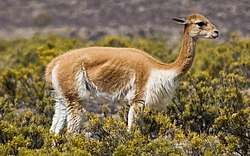


The weight of even-toed ungulates is borne about equally by the third and fourth toes, rather than mostly or entirely by the third as in perissodactyls. There are about 220 noncetacean artiodactyl species, including many that are of great economic importance to humans.
- Family: Bovidae (bovids)
- Subfamily: Antilopinae
- Subfamily: Caprinae
- Genus: Hemitragus
- Himalayan tahr, H. jemlahicusNT introduced, possibly extirpated [15]
- Genus: Hemitragus
- Family: Tayassuidae (peccaries)
- Genus: Catagonus
- Chacoan peccary, Catagonus wagneriEN
- Genus: Dicotyles
- Collared peccary, Dicotyles tajacu LC
- Genus: Tayassu
- White-lipped peccary, Tayassu pecariVU
- Genus: Catagonus
- Family: Camelidae (camels, llamas)
- Family: Cervidae (deer)
- Subfamily: Capreolinae
- Genus: Blastocerus
- Marsh deer, Blastocerus dichotomusVU
- Genus: Hippocamelus
- Taruca, Hippocamelus antisensisVU
- South Andean deer, Hippocamelus bisulcusEN
- Genus: Mazama
- Red brocket, Mazama americanaDD
- Gray brocket, Mazama gouazoupira LC
- Pygmy brocket, Mazama nanaVU
- Genus: Odocoileus
- Genus: Ozotoceros
- Pampas deer, Ozotoceros bezoarticusNT
- Genus: Pudú
- Southern pudú, P. puda NT
- Genus: Blastocerus
- Subfamily: Cervinae
- Subfamily: Capreolinae
Order: Cetacea (whales, dolphins and porpoises)


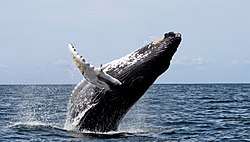

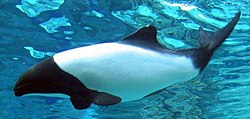




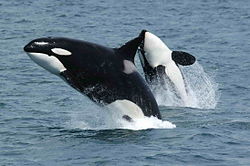


The infraorder Cetacea includes whales, dolphins and porpoises. They are the mammals most fully adapted to aquatic life with a spindle-shaped nearly hairless body, protected by a thick layer of blubber, and forelimbs and tail modified to provide propulsion underwater. Their closest extant relatives are the hippos, which are artiodactyls, from which cetaceans descended; cetaceans are thus also artiodactyls.
- Parvorder: Mysticeti
- Family: Balaenidae
- Genus: Eubalaena
- Southern right whale, Eubalaena australis LC
- Genus: Eubalaena
- Family: Balaenopteridae
- Subfamily: Balaenopterinae
- Genus: Balaenoptera
- Common minke whale, Balaenoptera acutorostrata LC
- Antarctic minke whale, Balaenoptera bonaerensisNT
- Sei whale, Balaenoptera borealisEN
- Bryde's whale, Balaenoptera edeniNE
- Blue whale, Balaenoptera musculusEN
- Fin whale, Balaenoptera physalusVU
- Genus: Balaenoptera
- Subfamily: Megapterinae
- Genus: Megaptera
- Humpback whale, Megaptera novaeangliae LC
- Genus: Megaptera
- Subfamily: Balaenopterinae
- Family: Neobalaenidae
- Genus: Caperea
- Pygmy right whale, Caperea marginata LC
- Genus: Caperea
- Family: Balaenidae
- Parvorder: Odontoceti
- Family: Physeteridae
- Genus: Physeter
- Sperm whale, Physeter macrocephalusVU
- Genus: Physeter
- Family: Kogiidae
- Genus: Kogia
- Pygmy sperm whale, Kogia brevicepsDD
- Dwarf sperm whale, Kogia simaDD
- Genus: Kogia
- Family: Ziphidae
- Genus: Ziphius
- Cuvier's beaked whale, Ziphius cavirostris LC
- Genus: Berardius
- Arnoux's beaked whale, Berardius arnuxiiDD
- Genus: Tasmacetus
- Shepherd's beaked whale, Tasmacetus shepherdiDD
- Subfamily: Hyperoodontinae
- Genus: Hyperoodon
- Southern bottlenose whale, Hyperoodon planifrons LC
- Genus: Mesoplodon
- Andrews' beaked whale, Mesoplodon bowdoiniDD
- Gray's beaked whale, Mesoplodon grayiDD
- Hector's beaked whale, Mesoplodon hectoriDD
- Strap-toothed whale, Mesoplodon layardiiDD
- Genus: Hyperoodon
- Genus: Ziphius
- Superfamily: Inioidea (river dolphins)
- Family: Pontoporiidae
- Genus: Pontoporia
- La Plata dolphin, Pontoporia blainvilleiVU
- Genus: Pontoporia
- Family: Pontoporiidae
- Superfamily: Delphinoidea
- Family: Phocoenidae (porpoises)
- Genus: Phocoena
- Spectacled porpoise, Phocoena dioptrica LC
- Burmeister's porpoise, Phocoena spinipinnisNT
- Genus: Phocoena
- Family: Delphinidae (marine dolphins)
- Genus: Cephalorhynchus
- Commerson's dolphin, Cephalorhynchus commersonii LC
- Chilean dolphin, Cephalorhynchus eutropiaNT
- Genus: Tursiops
- Common bottlenose dolphin, Tursiops truncatus LC
- Genus: Stenella
- Pantropical spotted dolphin, Stenella attenuata LC
- Striped dolphin, Stenella coeruleoalba LC
- Spinner dolphin, Stenella longirostris LC
- Genus: Delphinus
- Long-beaked common dolphin, Delphinus capensisDD
- Short-beaked common dolphin, Delphinus delphis LC
- Genus: Lagenodelphis
- Fraser's dolphin, Lagenodelphis hosei LC
- Genus: Lissodelphis
- Southern right whale dolphin, Lissodelphis peronii LC
- Genus: Lagenorhynchus
- Peale's dolphin, Lagenorhynchus australis LC
- Hourglass dolphin, Lagenorhynchus cruciger LC
- Dusky dolphin, Lagenorhynchus obscurus LC
- Genus: Grampus
- Risso's dolphin, Grampus griseus LC
- Genus: Orcinus
- Orca, Orcinus orcaDD
- Genus: Pseudorca
- False killer whale, Pseudorca crassidensNT
- Genus: Globicephala
- Long-finned pilot whale, Globicephala melas LC
- Genus: Cephalorhynchus
- Family: Phocoenidae (porpoises)
- Family: Physeteridae